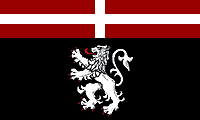Aosta
| |||
| Subdivision of: | Italy | ||
| Cities: | |||
| Capital: | Aosta | ||
| Largest: | Aosta | ||
| Other: | La Salle Pont-Saint-Martin | ||
| Languages: | |||
| Official: | Italian Valdoten Piedmontese French | ||
| Others: | Helvetian | ||
| Duke: | Amadeo III d'Aosta | ||
| President: | Luciano Caveri (Unione Valdoteniana) | ||
| Area: | 3,263 sq. km | ||
| Population: | 123,973 inhabitants (2005) | ||
| Established: | 1845, Duchy of Aosta declared | ||
Aosta is a small nation in northwestern Italy. It contains the highest point in Italy, Mont Blanc.
Administration
Government
Aosta, unlike many of the other provinces of Italy, does not follow a parliamentary system, though there is an elected assembly. Every five years, general elections are held to fill a council of 30, as well as a president. The council meets to propose and discuss laws, directed by the president. Once the council passes a law, the law is put to a popular referendum, requiring a simple majority to go into effect. The law then goes before the Duke, who signs it to confirm it. Technically, the Duke may choose to veto the law, but this has not happened in many years.
It is also worth noting that Aosta is the only state in Italy to have a completely privatized education system, a result of a 1997 initiative by the Neocapitalists.
Geography
The highest mountain in Italy, Mont Blanc, is located on the Aosta-France border. The Dora Baltea, one of the Po's tributaries, also flows through it, providing power for most of the province, as well as parts of neighboring Piedmont.
Borders
Aosta is bordered by:
North: Helvetia
West: France
South: Piedmont
East: Piedmont
Economy
Aosta was for a long time largely devoted to agriculture, but in recent years, a number of hydroelectric power plants on the Dora Baltea have brought in more important industries, including metalworks.
Culture
Aosta is a place of contradictions, in language, politics, and religion.
Language
Aosta is well-known throughout Italy as a stronghold of French culture. There is a high population of French-speakers in Aosta (the highest, percentage-of-the-population-wise, in Italy, at 30% first- and second-language speakers). However, the language that is foremost in the hearts of most Aostans is Valdoten, the local Franco-Provençal language. The main local political party, the Valdoten Union (currently Aosta's ruling political party), seeks to encourage the use of Valdoten throughout Aosta, and supports efforts to increase the use of local languages throughout Italy. To further confuse the mix, an Aostan band called Viva Italia has just begun to achieve national prominence, mostly for their unique writing style--all of their songs are written and sung in Italian, even though all the band members are native Valdoten-speakers.
Politics
Strangely enough, given its penchant for strong local government and excellent social service programs, Aosta is a center of Neocapitalist activity in Italy. The national headquarters of the Radical Party, the only Neocapitalist party to operate on the national level in Italy, is located in Point-Saint-Martin in the southeast of Aosta, and the PR has local chapters throughout the duchy.
Religion
Unlike much of Italy (indeed, unlike anywhere else in the world), Aostans belong primarily to an extralineal sect of Christianity known as the Cathars. Persecuted in their original home in France, some Cathars fled in the 1220s to the Aosta Valley, concealing their beliefs behind a mask of Roman Rite Catholicism. However, Catharism began, slowly and underground, to spread, especially on the northern border with Helvetia, and eventually became so prevalent that for the disgruntled Catholic church to attempt a forced conversion or another Albigensian Crusade would have been tantamount to executing the entire population of Aosta. Admittedly, the somewhat extreme views of the original Cathars have been long-since tempered by centuries in hiding, they have emerged relatively intact, especially the strong belief in pacifism. This pacifism, which led Aosta to surrender peacefully when Napoleon invaded, is seen as the guiding factor that lead to the survival of Valdoten as a major Italian language today (as compared to other minority languages that were suppressed under French rule, Valdoten effectively was allowed to persist in exchange for the Aostans' not resisting French government).
| |||
|---|---|---|---|
| Member Entities | |||
| Aosta | Ceva | Elba | Friuli | Liguria | Lombardy | Mantova | Marches | Massa | Metropolitan Duchies | Montferrat | Modena | Novellara | Parma | Piedmont | Piombino | Romagna | Trento | Tuscany | Umbria | Veneto |
